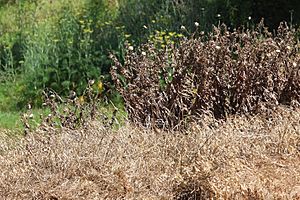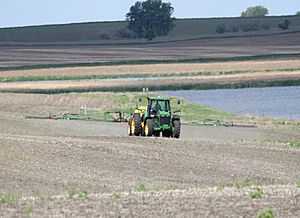Herbicide facts for kids
Herbicides, also known as weedkillers, are special chemicals. People use them to control plants they don't want, like weeds.
There are two main types:
- Selective herbicides target specific types of weeds. They leave important crops like corn or wheat unharmed.
- Non-selective herbicides kill almost all plants they touch. People use them to clear areas like construction sites or railway tracks.
Long ago, people used things like common salt to kill weeds. But these old methods often stayed in the soil for too long. They could also be harmful to the environment and groundwater (water underground). Because of this, many old weedkillers are now banned.
Herbicides have even been used in wars, but this is rare. Today, many modern herbicides act like natural plant hormones. They mess with how unwanted plants grow. The term organic herbicide means weedkillers used in organic farming.
Contents
History of Herbicides
Before modern herbicides, farmers used other ways to control weeds. They would change the soil pH or how much salt was in the soil. They also used machines to dig up weeds, a method called tillage. People still use these methods today.
First Modern Weedkillers

Scientists started studying herbicides in the early 1900s. A big discovery happened during World War II. Scientists in the United Kingdom and the United States were looking for ways to use chemicals in war.
In 1940, a scientist named W. G. Templeman in the UK found something important. He showed that certain chemicals could kill broad-leaved weeds in cereal fields. These chemicals did not harm the cereal crops. By 1941, his team made the chemical. At the same time, R. Pokorny in the US also made it.
Another team, led by Juda Hirsch Quastel, made the same discovery. They worked at the Rothamsted Experimental Station. Quastel's team studied how chemicals affected plant growth in soil. Their work led to the discovery of a compound called 2,4-D.
When 2,4-D was sold in 1946, it changed farming around the world. It was the first successful selective herbicide. It helped farmers control weeds much better in crops like wheat, maize (corn), and rice. This is because 2,4-D kills broadleaf plants (dicots). But it does not harm most grasses (monocots). 2,4-D is still one of the most used herbicides today because it is cheap.
New Discoveries in Herbicides
In the 1950s, a new group of herbicides called triazines came out. One of these is atrazine. However, atrazine can stay in the soil for a long time. It can also get into groundwater, which is a concern.
Glyphosate, known as Roundup, was introduced in 1974. At first, it killed all plants. But then, scientists developed crop plants that were resistant to glyphosate. This meant farmers could spray glyphosate on their fields. It would kill the weeds but not their special crops. This changed how seeds and chemicals were sold in the late 1990s.
Many modern herbicides used in farming and gardening break down quickly. This is good because new crops can be planted soon after. They won't be harmed by the herbicide. But some situations need herbicides that last longer. For example, to stop weeds from growing under new roads or buildings.
How Herbicides Work
Herbicides are grouped in different ways. This can be by how they work or when they are used.
Controlling Unwanted Plants
- Control means destroying unwanted weeds. Or damaging them so they don't compete with the crop.
- Suppression means partly controlling weeds. This still helps the crop, for example, by reducing how much the weeds compete.
- Crop safety means the herbicide does not harm the main crop. Most selective herbicides cause a little stress to crop plants.
- A Defoliant is like a herbicide. But it is made to remove leaves, not to kill the whole plant.
Selective vs. Non-selective Herbicides
Herbicides can be selective or non-selective. This depends on what plants they affect.
- Selective herbicides control certain plants without harming others. For example, 2,4-D, mecoprop, and dicamba kill many broadleaf weeds. But they do not harm lawn grasses.
- Non-selective herbicides kill almost all plants they touch. They are used to clear areas like industrial sites or railways. Examples include paraquat, glufosinate, and glyphosate.
Many things can affect how well herbicides work. These include:
- Plant differences: Plants can be different in their shape, how they grow, or how their bodies work. These differences can make a herbicide selective.
- Weather: Things like humidity, light, rain, and temperature matter.
- High humidity helps herbicides get into leaves.
- Bright light can make some herbicides break down.
- Rain can wash away herbicides on leaves. But it helps soil-applied herbicides get into the roots.
- Very cold weather can make herbicides less effective.
See also
 In Spanish: Herbicida para niños
In Spanish: Herbicida para niños



